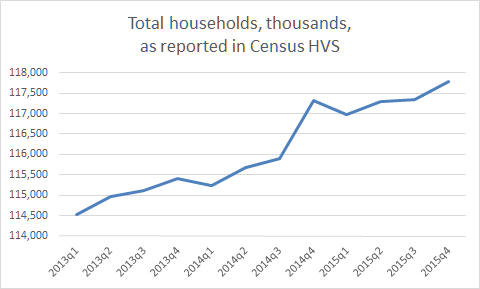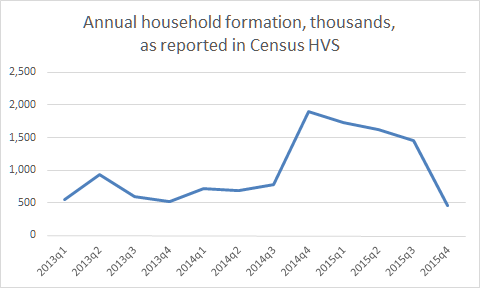Today the Census’s Homeownership and Vacancy Survey (HVS) reported that household formation was just 462 thousand in 2015 Q4 compared with a year earlier. Household formation is a key indicator of housing demand, and that 2015 Q4 estimate rivals those at the worst of the recession.
But there’s no need to panic. I don’t see how that household formation number can be right. The problem might be that the HVS updated the housing-unit controls used in this report. The result is an implausible time series in the number of households, which jumps suddenly in 2014 Q4:
Household formation equals the year-over-year change in total households. Therefore, household formation was reported to have jumped up for four quarters (2014 Q4 – 2015 Q3) and then to have plummeted in 2015 Q4:
Fortunately, there’s an alternative method for estimating household formation that sidesteps the HVS housing-unit controls. (See this previous post on household formation.) The number of households equals the number of adults times the headship rate, which is defined as the number of households per adult. Among adults 16+, the headship rate is roughly 50% — in other words, there are about two adults age 16+ in the average household. We can combine several facts from other Census sources:
- The U.S. civilian non-institutionalized population age 16+ was a hair under 250 million in December 2014.
- The U.S. civilian non-institutionalized population (all ages) was estimated to have grown 0.8% in 2015. Separately, the total resident population age 16+ had been projected to grow 1.0% in 2015. There’s no good estimate of the growth of the civilian non-institutional population age 16+ specifically, but somewhere in the 0.8%-1.0% range is a safe estimate.
- The headship rate for civilian non-institutionalized adults age 16+ fell ever so slightly from 50.06% in 2014 Q4 to 50.02% in 2015 Q4, according to my calculations from Current Population Survey basic monthly microdata files.
Multiplying the adult population in each time period by the headship rates yields an estimate for the number of households. In 2014 Q4, that equaled 124.9 million. In 2015 Q4, that equaled something in the range of 125.8 – 126.1 million, depending on whether you use the 0.8% or 1.0% estimate of adult civilian non-institutionalized population growth. The change over time is household formation, which this method suggests is in the 900-1150 thousand range. Even the low point of that range is nearly twice the rate of household formation of 462 thousand reported by the Census.
The stagnant headship rate is a disappointment and a surprise. The aging of the population alone should raise the headship rate since older adults live in smaller households than younger adults do. Furthermore, the economic recovery should encourage more young people to form households, further lifting the headship rate. So the slight decline in headship, and resulting household formation of 900-1150 thousand, is nothing to celebrate. But it’s far from the disaster that the HVS estimate of 462 thousand suggests.

